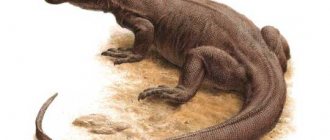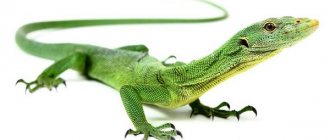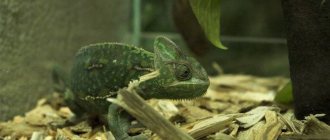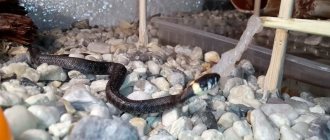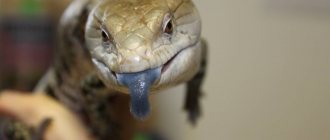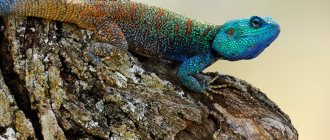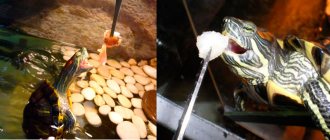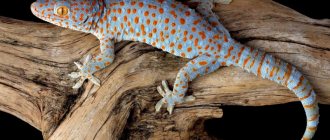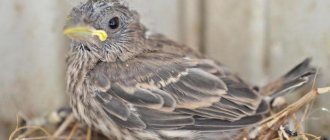Lizard: description
Usually all reptiles with legs are considered lizards, but they also include several without legs. There are a lot of species of lizards; according to zoologists, more than 6,000 different species of lizards live on our planet, and all of them, of course, differ in their habits, appearance, color and habitat. Some of the especially exotic species of lizards are currently on the verge of extinction and for this reason are listed in the Red Book.
The most common real lizard has a body length of 10-40 cm. The lizard's body is long, elastic, elongated and has a long tail.
Unlike their snake relatives, lizards have movable and divided eyelids. The lizard's paws are of medium length, have claws and are generally proportional to its body covered with keratinized scales. The lizard's skin peels off during molting a couple of times per season; in some languages of the world, this amazing feature of these reptiles to change their skin even gave them their name. In particular, in our language the word “lizard” comes from the Old Russian word “skora”, which means “skin”, or “skin” if more literary.
The lizard's tongue, depending on the species, has a different shape and size; in general, it is mobile and easily protrudes from the mouth. And some lizards even use their tongues to catch fish.
Lizards' teeth are also their weapons; with their help, they capture and grind food, and monitor lizards have sharp teeth that literally cut prey. There is also a single poisonous representative among lizards, named accordingly - the poisonous tooth, which, with a bite like snakes, injects poison into its victim, thus killing it.
The skin of a lizard can have a variety of colors and patterns, depending on the species.
The color (color) of the lizard also differs, which many species are able to change depending on the situation, sometimes literally merging with the surrounding area - color mimicry is one of their main means of defense. Typically, lizards have a combination of gray, brown and green colors.
Appearance
There is no uniformity in the appearance of lizards, with the exception of the background coloring of the body, designed to camouflage the reptile among its native landscape. Most of the lizards are colored green, gray, brown, olive, sand or black, whose monotony is enlivened by various patterns (spots, stains, diamonds, longitudinal/transverse stripes).
There are also very noticeable lizards - the long-eared round-headed lizard with a scarlet open mouth, the bearded dragon, and colorful (yellow and orange) flying dragons. The size of the scales varies (from small to large), as does the way they are laid on the body: overlapping, like a tile roof, or end to end, like tiles. Sometimes the scales transform into spines or ridges.
In some reptiles, such as skinks, the skin gains special strength from osteoderms, bony plates that are located inside the horny scales. The jaws of lizards are lined with teeth, and in some species, teeth even grow on the palatine bones.
This is interesting! The methods for attaching teeth to the oral cavity vary. Pleurodont teeth are periodically replaced and therefore do not sit firmly on the inside of the bone, unlike acrodont teeth, which are not replaced and completely fuse with the bone.
Only three species of lizards have acrodont teeth - amphisbaenas (two-walkers), agamas and chameleons. The limbs of reptiles are also structured differently, which is due to their way of life, adapted to a certain type of earth’s surface. In most climbing species, geckos, anoles and some skinks, the underside of the fingers is transformed into a pad with setae (hair-like outgrowths of the epidermis). Thanks to them, the reptile tenaciously holds onto any vertical surfaces and quickly crawls upside down.
Lifestyle, behavior
Lizards primarily lead a terrestrial lifestyle; they can burrow into the sand (roundheads), crawl onto bushes/trees and even live there, from time to time embarking on gliding flights. Geckos (not all) and agamas easily move along steep surfaces and often inhabit rocks.
Some species with an elongated body and the absence of eyes have adapted to existence in the soil, others, for example, the sea lizard, love water, so they live on the coasts and often refresh themselves in the sea.
Some reptiles are active during daylight hours, while others (usually with a slit-like pupil) are active at dusk and at night. Some people can change their color/brightness due to the dispersion or concentration of pigment in melanophores, special skin cells.
This is interesting! Many lizards have retained the parietal “third eye”, inherited from their ancestors: it is not capable of perceiving form, but distinguishes between darkness and light. The eye on the crown is sensitive to ultraviolet radiation and regulates hours of sun exposure and other forms of behavior.
Contrary to popular belief that most lizards are poisonous, only two closely related reptiles from the family of lizards have this ability - the escorpion (Heloderma horridum), which lives in Mexico, and the vest (Heloderma suspectum), which inhabits the southwestern United States. All lizards molt from time to time, renewing the outer layer of skin.
Range, habitats
Lizards have settled throughout the planet, except Antarctica. They live on other continents, on the Eurasian continent reaching the Arctic Circle, in that part of it where the climate is moderated by warm ocean currents.
Lizards are found at different altitudes - below sea level, for example, in Death Valley (California) and extremely high, at around 5.5 km above sea level (Himalayas). Reptiles have adapted to various habitats and landscapes - coastal shallows, semi-deserts, deserts, steppes, jungles, mountains, forests, cliffs and wet valleys.
How are snakes different from lizards?
Those types of lizards that do not have legs are almost the same in appearance as snakes. Such lizards include, for example, the copperhead, which many take for a snake, although in fact it is a lizard that simply does not have legs. But how can one distinguish such a legless lizard from real snakes?
- The first difference between snakes and lizards is their eyelids. In snakes, the eyelids have grown together and become transparent, for this reason snakes never blink. In lizards, on the contrary, the eyelids are movable and blinking is in the order of things.
- A snake does not have hearing organs, but a lizard has them; on both sides of its head there are ear openings closed by eardrums.
- Molting of both snakes and lizards occurs differently, snakes try to shed their skin in one fell swoop, after soaking in water, while lizards shed gradually, shedding their skin in pieces.
Venomous teeth
Poisonous species of lizards , two of them are currently known - Arizona and Mexican. They have a dense, ridged body, a short tail with reserves of fat and a flat head. Paws are five-fingered with sharp long claws. The coloring, like many dangerous creatures, is warning.
Variegated, with bright yellow-red spots on a dark background. They prefer rocky desert areas, but do not like extreme dryness. But they love to swim, and row with their paws like oars. In winter they hibernate. Usually slow, but develop good speed in water.
They love bird and turtle eggs, although they feed on all living things. They search for prey using their tongue, which is constantly protruding and vibrating. The venom from the bite is not fatal, but it brings very unpleasant sensations - swelling, enlarged lymph nodes, difficulty breathing, dizziness and weakness. In addition, the wound may become infected. But they themselves do not attack people. Typically, bites occur during capture or after poor conditions in captivity.
How to distinguish a newt from a lizard?
Also, sometimes lizards are confused with newts, and, of course, they have a lot in common: similar structure of paws and body, snake-like head, long rounded tail, movable eyelids and much more. But there are still a number of differences between it:
- The most important difference is the different structure of the skin; if lizards have scaly skin, then in newts it is completely smooth and slimy to the touch.
- Newts do not know how to throw off their tail, while lizards easily and simply get rid of this part of their body in case of danger.
- Lizards have a hard and ossified skull, while newts have a cartilaginous skull.
- While lizards breathe exclusively through their lungs, newts are able to breathe through both their lungs and gills, and even through their skin.
- If lizards reproduce by laying eggs, then newts conduct their reproduction process like fish - in water and through spawning.
Lizard tail. How does a lizard cast its tail?
One of the most amazing and unique features of the lizard is, of course, its ability to throw away its tail in emergency situations, or autotonia as this phenomenon is scientifically called. How does this happen? Contraction of the lizard's tail muscles allows it to break the cartilaginous formations of the vertebrae and thus throw off most of the tail. In this case, the blood vessels are greatly narrowed, and there is practically no blood loss during this procedure. The discarded tail continues to wriggle for some time, thereby distracting the enemy, and the lizard manages to hide during this time. Over time, the lizard's tail grows back, albeit in a somewhat shortened form.
An interesting fact: it also happens that after autotonia, a lizard grows not one, but two or even three tails.
Natural enemies
Lizards, especially small and medium-sized ones, are constantly trying to be grabbed by larger animals - terrestrial and feathered predators, as well as many snakes. The passive defensive technique of many lizards is widely known, which looks like throwing away its tail, distracting the attention of enemies.
This phenomenon, possible due to the middle non-ossified portion of the caudal vertebrae (except those close to the body), is called autotomy. Subsequently, the tail is regenerated.
Each species develops its own tactics for avoiding direct collisions; for example, the long-eared roundhead, if it cannot dive for cover, takes a frightening pose. The lizard spreads its legs and tenses its body, inflates, simultaneously opening its mouth wide, whose mucous membrane becomes filled with blood and turns crimson. If the enemy does not leave, the roundhead can jump and even use its teeth.
Other lizards also stand in a threatening pose when danger approaches. Thus, Chlamydosaurus kingii (Australian frilled lizard) sharply opens its mouth, simultaneously raising a bright collar created by a wide neck fold. In this case, enemies are scared away by the effect of surprise.
How to distinguish a male from a female lizard?
Male and female lizards look almost the same, although there are a number of signs by which the sex of the lizard can be determined.
- In some species of lizards, such as basilisks and green iguanas, the males have a brightly colored crest on their back.
- Spurs on the paws are another sign of a “man” among lizards.
- You can also determine the sex of a lizard by the throat sacs that some species have.
In general, all methods for determining the sex of a lizard are not perfect, and you can find out for sure whether it is a boy or a girl only through a testosterone test of the lizard’s blood done in a professional veterinary clinic.
Fusiformes
This infraorder includes 3 families, which include about 800 species. It is noteworthy that this type of reptile is also often confused with snakes. This is due to the peculiarity of the detachment. Some species of fusiformes have no limbs, which makes them look like snakes.
All representatives of this order have scales supported by small bone plates. This sets them apart from other orders of lizards. It is noteworthy that not all fusiform species are limbless.
Domestic reptile species
This group contains lizards that live at home and participate in various exhibitions and other events.
Yemen chameleon
At home, reptiles often get sick and are subject to stress. They require careful and special care. Chameleons are distinguished by their inimitable beauty in appearance. Individuals are capable of changing color. At the beginning of their life, the body has a greenish-light green tint, which is later diluted with wide stripes. The change in color of a reptile depends on its mood and status.
Three-horned chameleon
The pet can also change its color. The second name for the chameleon is “Jackson's lizard.” A peculiarity of the reptile is the presence of three horns, the longest and thickest of which is the central one. Lizards have a strong tail and can move deftly through trees.
Common spiketail
On the outer side of the reptile's tail there are spike-like processes. Lizards can grow up to 75 cm, so in some cases keeping them in the house is very difficult and even impractical. If the spiketail is frightened, it can attack and even bite.
Australian agama
Water-loving lizards have tenacious claws and long limbs, thanks to which they deftly climb trees. The animals grow up to 800 g, they are very careful and dive and swim with ease.
Panther chameleon
This type of lizard is considered one of the cutest and largest. Various colors depend on the habitat. Animals can have scales of blue, red-green, gray-yellow, light green and other colors. Quite often, reptiles curl their tails into a kind of donut. They feed on insects and can live up to 5 years at home.
Fantastic gecko
The most skillful camouflage plant that blends perfectly with the background of the leaves. Lizards have a flat tail, uneven body and brownish, rough scales. This is one of the most suitable reptiles for keeping at home.
frilled lizard
The reptile closely resembles a small dragon. A large fold of skin located on the neck may swell and change color. To enhance the effect, the animal stands on its hind legs. The individual has a gray-brown or bright red body with light and dark spots.
Leopard gecko
A cute lizard with yellow and white scales with spots like a leopard. The abdomen of reptiles is white, the body can reach 25 cm in length. Caring for a lizard at home is quite simple.
Eyelash banana gecko
The owner of a long body, an ideal camouflage. This rare species of reptile is distinguished by its unique “cilia” (skin extensions located above the eye sockets). The animal loves bananas, mangoes, and other fruits.
Green iguana
One of the large, massive and agile lizards, which has small horns on the top of its head. The weight of the animal can reach 9 kg. The iguana has a wide crest on its back. To keep a lizard at home you will need a very large area.
Fire skink
A lizard that is mistaken for a snake. The reptile has a wide body and short legs, which are practically invisible, which is why it seems that the skink is crawling and not walking on the ground. The length of the lizard reaches 35 cm.
Blue tongue skink
A similar species of lizard that has a long, light blue tongue. The animal grows up to 50 cm and has smooth scales.
Black and white tegu
An impressive size reptile, growing up to 1.3 meters. The diurnal predator feeds on rodents, slowly killing its prey. The lizard has large eyes, a pale pink tongue and short limbs.
Water dragon
An amazing lizard that regenerates both limbs and gills. Reptiles come in pink, purple, gray and other colors. The water dragon looks like a fish with sharp teeth that allow it to hold its prey.
Wild reptiles
Among the lizards living in the wild are:
Fast lizard
The fast lizard comes in gray, green and brown colors and can throw off its tail. Small animals are very dexterous and quick, and can eat their own offspring.
Proboscis anole
The proboscis anole is a rare species of nocturnal lizard that resembles a crocodile due to its long, elephant-like nose. Reptiles are light green or brown-green in color.
Worm-like lizard
Worm-shaped lizard - a reptile similar to an earthworm; there are no limbs on the animal’s body. It crawls along the ground, its eyes hidden under the skin.
Komodo dragon
The Komodo dragon is the largest reptile, reaching a mass of 60 kg and a length of 2.5 meters. The lizard's bite is poisonous and can lead to dire consequences.
Tree agama
The tree agama is a lizard that climbs trees thanks to its sharp claws and tenacious paws. The body of reptiles is gray or olive in color, the tail is yellow-gray.
Gecko currents
The current gecko is a lizard with a strong body that is covered with gray and blue scales. Individuals grow up to 30 cm, feed on insects and small vertebrate animals.
Ring-tailed iguana
Ring-tailed iguana - features of the lizard are a long tail, light scales with dark stripes, thick scales on the face that resemble horns.
Other notable lizard species include the marine iguana, Arizona adobe, lobe-tailed gecko, spindle-tailed skink and monkey-tailed skink.
Gecko-like
This is an infraorder of reptiles, which includes seven families, which include about a thousand species. A common feature of this type of lizard is the muscle located in the ear area. In addition, the order is characterized by the absence of a zygomatic arch.
The most famous representative of the gecko-like species is the green felsuma. This animal is the largest in its order. Its length can reach more than thirty centimeters. The reptile's body is painted in a bright light green color. The reptile spends the main part of its life in trees. There it feeds on ripe fruits and various insects.
The largest lizard in the world is the Komodo dragon
Of the existing representatives of lizards, the largest is the Komodo monitor lizard (giant Indonesian monitor lizard, Komodos monitor). Some specimens are striking in their size, reaching almost three meters in length and weighing 80-85 kg at maturity. By the way, the Guinness Book of Records includes a “dragon” from Komodo Island, which weighed 91.7 kg. These giants eagerly eat small animals - turtles, lizards, snakes, rodents, and do not disdain impressively sized prey. The Komodo dragon often feeds on wild boars, wild goats, cattle, deer or horses.
Monitor lizards
This infraorder includes only one genus - monitor lizards. In turn, they are divided into 70 species. These animals live in Africa, Australia and New Guinea. The largest representative of the order is the Komodo Dragon. This reptile can reach 3 meters in length and weigh up to 120 kilograms.
Young Komodo dragons feed on small birds and animals. However, the larger they grow, the larger their prey becomes. An adult representative of this species can easily devour an animal the size of a sheep. It is noteworthy that these monitor lizards can eat an amount of meat equal to 80% of their own body weight in a day.
Sense organs
The eyes of reptiles, depending on the species, differ in a greater or lesser degree of development: all diurnal lizards have large eyes, while burrowing species are small, degenerate and covered with scales. Many people have a movable scaly eyelid (lower), sometimes with a transparent “window” occupying a large area of the eyelid, which grows to the upper edge of the eye (which is why it sees as if through glass).
This is interesting! Some geckos, skinks and other lizards have such “glasses”, whose unblinking gaze resembles that of a snake. Reptiles with movable eyelids have a third eyelid, a nictitating membrane that looks like a transparent film that moves from side to side.
Those lizards that have openings in the external auditory canals with eardrums catch sound waves with a frequency of 400–1500 Hz . The rest, with non-working (clogged with scales or completely disappeared) auditory openings perceive sounds worse than their “eared” relatives.
A key role in the life of lizards is played by the Jacobson organ, located in the front part of the palate and consisting of 2 chambers connected to the oral cavity by a pair of holes. The Jacobson organ identifies the composition of a substance that enters the mouth or is in the air. The mediator is the protruding tongue, the tip of which the reptile moves towards the Jacobson's organ, designed to determine the proximity of food or danger. The lizard's reaction depends entirely on the verdict rendered by the Jacobson organ.
What do lizards eat in the wild?
Lizards are omnivores; after all, they are predators and their diet directly depends on the type and size of a particular lizard. Small lizards eat various insects: butterflies, grasshoppers, locusts, snails, and various worms. Larger lizards, for example, monitor lizards, hunt various small animals: frogs, snakes, mice, and do not mind eating bird eggs. And the largest lizards, monitor lizards from Komoda Island, even attack wild boars, buffalos and deer.
Lizards first sneak up on their prey unnoticed, then make a swift dash and overtake it with their claws and sharp teeth.
Since lizards are omnivores, they can also eat vegetarian food - plant pollen, ripe fruits, tree leaves. There are species of lizards that lead a completely vegetarian lifestyle, but most lizards still like to eat meat.
Vermiformes
This squad is the most unusual. Many people often mistakenly classify snakes as this because they look like this type of lizard. However, this is not the case. These reptiles are similar to snakes in that they have no limbs and have an elongated body shape. But the general features are limited to this. Worm-like lizards also do not have eyes or ears. Therefore, this reptile resembles not a snake, but a worm. These reptiles live in the United States.
Reproduction
During the mating season, males of many lizard species acquire bright colors. They are characterized by peculiar courtship games, during which the male demonstrates bright body color in front of the female, taking specific “courtship” poses, to which the female responds with certain signaling body movements, consisting, for example, of swaying or trembling of the raised front legs and wriggling of the tail.
The vast majority of lizards lay eggs, the number of which in one clutch ranges from 1-2 in the smallest species to 8-20 in medium-sized ones and several dozen in large lizards. The eggs are enclosed in a thin, moisture-permeable, colorless, leathery shell that can stretch during embryo development. Usually the female lays her eggs in a hole or shallow hole, then covering it with soil. Eggs are often laid under stones, in rock cracks, in hollows or under the bark of trees, in wood dust, and by some geckos they are glued to tree trunks and branches.
A minority of lizards are ovoviviparous. Their eggs, devoid of a dense shell, develop inside the mother’s body, and the cubs are born alive, freeing themselves from the thin film that covers them in the oviducts or immediately after birth. True viviparity has been established only in some skinks and American night lizards Xanthusia, the embryos of which receive nutrition through the false placenta - blood vessels in the walls of the mother's oviducts. Viviparity is usually associated with harsh living conditions, for example, living in the far north or high in the mountains.
In most cases, having laid eggs, the female never returns to them, and the developing embryos are left to their own devices. Real care for the offspring is observed only in some skinks and spindles, the females of which wrap themselves around the laid eggs, periodically turn them over, protect them from enemies, help the young free themselves from the shell and, remaining with them for the first time after hatching, give them food and protect them in case of danger .
Some species of lizards lay eggs with almost fully developed embryos, so the young can hatch within the next few days. By the time of hatching from the egg, the embryos develop a special egg tooth in the front corner of the mouth, with which, shaking its head, the young lizard, like a razor, cuts a gap in the egg shell to exit. Recently, the phenomenon of so-called parthenogenesis has been discovered in a number of lizards, when females lay unfertilized eggs in which normal offspring develop. There are no males during parthenogenesis, and such species are represented only by females.
Nutrition
Most lizards are predators, feeding on all kinds of animals that they are able to grab and overpower. The main food of small and medium-sized species are insects, spiders, worms, mollusks and other invertebrates. Larger lizards eat small vertebrates - rodents, birds and their eggs, frogs, snakes, other lizards, as well as carrion. A smaller number of lizards are herbivorous and eat fruits, seeds and succulent parts of plants. However, even among herbivores, young individuals, as a rule, first feed on insects and only later begin to feed on plants, losing their predatory instincts.
Many lizards are equally willing to eat both plant and animal foods. Some species are characterized by cannibalism: adults chase and eat young individuals of the same species. Food specialization in lizards is observed relatively rarely. Thus, marine iguanas feed predominantly on one type of algae, while other lizards eat almost exclusively ants or termites, often also only one species.
As a rule, lizards slowly creep up to their prey and then grab it in a final lunge. The prey is usually eaten whole, but may be torn apart by the jaws beforehand. Like other reptiles, lizards are able to remain without food for a long time, using up nutrient reserves deposited in fat bodies located in the body cavity.
Population and species status
Due to the large number of species, we will focus only on those included in the Red Book of Russia:
- medium lizard – Lacerta media;
- Przewalski's foot-and-mouth disease – Eremias przewalskii;
- Far Eastern skink – Eumeces latiscutatus;
- gray gecko – Cyrtopodion russowi;
- barbour foot-and-mouth disease – Eremias argus barbouri;
- Squeaky gecko – Alsophylax pipiens.
In the most dangerous position on the territory of the Russian Federation is the gray gecko, with its habitat in Art. Starogladkovskaya (Chechen Republic). Despite the high number in the world, the gray gecko has not been found in our country after 1935.
This is interesting! Barbour's foot-and-mouth disease is also rare in Russia, despite the high numbers in some places: near Ivolginsk (Buryatia) in 1971, 15 individuals were counted in an area of 10 * 200 m. The species is protected in the Daursky State Nature Reserve.
Population of the Far Eastern skink on the island. Kunashir numbers several thousand individuals. The species is protected in the Kuril Nature Reserve, but places with the maximum number of lizards are located outside the reserve. In the Astrakhan region, the number of squeaky geckos has decreased. Przewalski's foot-and-mouth disease occurs sporadically in the Russian Federation, more often on the periphery of its range. There are also a small number of medium-sized lizards, whose Black Sea populations suffer from excessive recreational pressure.
What to feed your lizard at home?
And many exotic species of lizards are very popular terrarium animals, among them the Yemen chameleon, bearded agama, true iguana and others. With proper care, lizards reproduce well and feel at ease. But if you decide to get a pet lizard, then you will be faced with the question of how to properly feed such an exotic pet.
Fortunately, the lizard is not whimsical in terms of food intake; in the warm season it needs to be fed three times a day, and in winter, due to the low activity of the lizard itself, it can be fed only twice a day. Well, mealworms, grasshoppers, spiders, fresh chicken eggs and pieces of raw meat are suitable food for the lizard. They say that lizards are very fond of a mixture of chopped boiled chicken, grated carrots and lettuce. It is also very important that the lizard always has fresh drinking water in its terrarium.
Iguanas
They live in America, as well as on the islands of Fiji, Galapagos and the Caribbean. Among them, true iguanas are recognized as the largest - up to 2 m in length. They are distinguished by pleurodont teeth, which grow on one side to the jaw bones. Interestingly, the lost tooth is soon replaced by a new one. Such capabilities are usually inherent in members of other families, but not agamas.
Interesting facts about lizards
- Basilisk lizards are able to move on water. And this is not a biblical miracle, but a physical law of nature; movement through the water is achieved by quickly and very often moving the lizard’s hind limbs.
- Lizards, like many other animals, are color blind, but unlike many of them, who see the world around them in black and white, lizards look at it through orange glasses in the most literal sense - they see the whole world as different shades of orange.
- Colombian gourmets consider the eggs of some lizards to be the greatest delicacy. There they even specially catch pregnant female monitor lizards and iguanas, cut their belly, take out the eggs, rub wood ash into the wound itself, after which the female is released, and the eggs end up on the dinner table.
